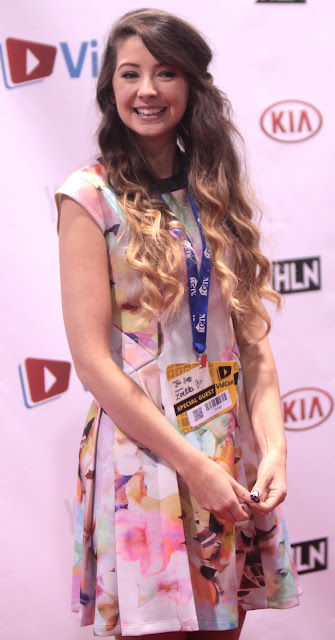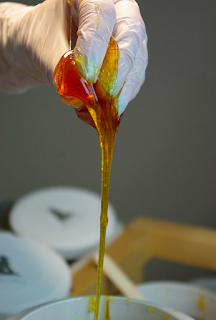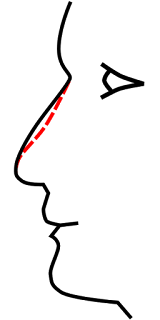Researching beauty in meat space – my brush with the beauty vloggers
My PhD research centred on beauty vloggers, namely, young
women who regularly produce beauty content on YouTube for a living – it’s their
jobs. In my work I demonstrate how although the beauty vlogger appears solo in
front of a camera, they rarely work alone. The UK (and many other countries)
has a sizable beauty vlogging industry, which (in addition to YouTube and brands)
also features a proliferating number of intermediaries, managers and ‘industry
experts’. A significant element of the beauty vlogging ecology is the
‘networking event’. These events are highly feminised and ostensibly centred on
leisure: they often featuring a ‘tea party’ or ‘cocktail’ theme, but are
branded through post-feminist logics of girl-boss empowerment. In highly
decorated rooms, often around a high-end centrepiece cake, stakeholders give
lectures, and successful vloggers and influencers speak on panels. Beauty and
lifestyle brands horseshoe around the peripheries of event locations, giving
out products that they hope will be ‘reviewed’ in vlogging content. The event
timetable affords significant time for chatting to brand reps in their booths,
exchanging your email address for goodies. During these interactions, some more
high-profile vloggers, are taken aside for a longer conversation. Even for events
that didn’t have an official ‘green room’ for featured creators, the hierarchy
was visible – the industry stars gathered near the stage. Wannabes (like me)
hung around in clumps near the edge of the action, like pocket lint in a dryer.
Although it’s easy to dismiss beauty vlogging as frivolous, I was struck by the
similarity of these events to academic conferences. In particular I felt, in my
bones, in the palpable nature of networking hierarchies, and that I was located
outside of them.
What do beauty vloggers look like?
A List beauty vloggers are beautiful, in that they are
physically attractive. They consistently represent and conform to beauty norms.
But what are beauty norms, exactly? In a recently published edited collection
by Elias, Schaff and Gill, entitled “Aesthetic Labour: Beauty Politics in
Neoliberalism", the authors claim their aim is to “mark out a new intellectual
terrain in beauty studies”(Elias, Gill, & Scharff, 2017: 5). In their introduction, they
speak of many categories and typologies of beauty in culture, including
“youthful beauty” (4) “beauty norms”(5) “politics of appearance” (6)
“unrealistic beauty ideals” (8) “Euro-American beauty ideals” (11) “ “clear
patterns relating to beauty” (19) “(hetero)sexual attractiveness” (25) “beauty
imperative” (25) to “look good” (29) and “female beauty” (31). Ultimately,
though these norms, ideals, patterns and styles of beauty are often unclear
and undefined. What are, for example, “European-American” beauty ideals, and
what is “heterosexual attractiveness”? At the most basic level, what does it
mean to “look good”? Speaking to these gaps, I consider it important to outline
the limited, but arguably culturally representative, performance of beauty
within the vlogging industry in the UK. At a broad level, I argue the aesthetic
architectures of beauty in the vlogging industry as hegemonic beauty. Bennett
defines Gramsci’s concept of hegemony as “moral, cultural, intellectual and
thereby, political leadership over the whole of society” (Bennett, 2006: 95). Building on this, I define
the oft-used/rarely-explained concept of hegemonic beauty as the temporally
and geographically determined, dominant cultural standards of beauty. In this
vein, access to physical attractiveness and beauty are stratified within
existing channels of structural power, stratified by class, race, age and
gender.
 |
| Zoe Sugg aka Zoella (Photo: Gage Skidmore) |
It is helpful to
think of beauty vloggers through the cultural lexicon of the Disney Princesses,
who serve as extreme examples of representations of normative and hegemonic
beauty. That beauty vloggers share more than a passing resemblance to Disney
Princesses has not gone unnoticed. MTV ran a feature in which they hired
illustrators to draw popular beauty vloggers as Disney princesses, drawing from
the Snow White canon by stating, “we would happily watch a feature length film
of Tanya Burr doing a makeup tutorial and instead of using foundation brushes
and stuff, birds applied her brushes instead” (MTV, 2015a). Burr is a UK based beauty vlogger, cosmetic
entrepreneur and actress with 3.6 million subscribers on YouTube. MTV also
published a piece about the most popular beauty vlogger in the UK, Zoella, who
has 12 million subscribers. The article is entitled “9 reasons Zoella is
basically a real life Disney princess” explaining that this is due to her red
lips, her eyes being the “size of Mars” and that “her hair is always flawless” (MTV, 2015b). The Telegraph observes “[Zoella] looks like a
Disney Princess” (Audley, 2014) and
lifestyle blog The Debrief called her “a pint size Disney princess made flesh” (Tsjeng, 2015). Historically, Disney Princesses illustrate
societal hegemonic beauty, the attractive women in popular culture at their
particular time. Snow White draws from a flapper girl aesthetic mixed with
Betty Boop, Sleeping Beauty’s Aurora is reminiscent of 1960’s Brigitte Bardot
and the then-newly released Barbie doll, and the Little Mermaid parallels
Jennifer Grey in Dirty Dancing (Do Rozario, 2004). Bell (1995)
argues “Disney artists sketched the flesh and blood on these folktale templates
with contemporaneous popular images of feminine beauty and youths” (Bell, 1995: 110). However, despite drawing
from the (very slightly) diverse beautiful women of their times, the Disney
Princesses become transformed by a specific Princess look. The princesses adhere to “a common set of feminine beauty
norms, regardless of their individual ethnicity: hourglass-shaped body, glossy
hair, long-lashed eyes, and heart-shaped face; hair colour and style are
emphasised as the primary distinguishing feature” (Wohlwend, 2009: 23). In other words, despite
Princesses being of seemingly diverse ethnicities, the Disney princess look is
ultimately raced European and white.
Similarly, the A List
beauty vloggers in my study are painted from this very narrow palette of
beauty: saucer-shaped big eyes, small button noses and heart-shaped faces. The
beauty vloggers in this case study embody what I describe as a healthful glow.
Borrowing from Deleuze, McRobbie observes “luminosities are suggestive of
post-feminist equality while also defining and circumscribing the conditions of
a status… within this cloud of light, young women are taken to be actively
engaged in the production of the self” (McRobbie, 2009: 60). Similarly, the cloud of
light beams around the healthful and glowing beauty vloggers, a glow can be
constructed and managed using products and lighting, however, the ability to
perform the glow as authentic and natural is stratified by skin colour: light
skin will always glow brighter.
Researching beauty
I don’t want to be a beauty influencer – or at least, I
don’t have the industry hook-ups, skills, tools, and temporal dedication that
this career necessitates in 2018. Why then, did attending beauty influencer
events consistently make me feel so bad? Yes, I am a researcher with an
ostensive distance, but it’s very hard not to care when what you look like,
when your meat-case determines how you move in the world, and where you can go.
Everyone knows this, but aesthetic industries write it up in neon lights. For
each event I tried to piece together a self-presentation strategy that would
help me fit in – this was expensive and time consuming. I probably couldn’t
really look like a beauty vlogger, but maybe I could look like a hip talent manager,
or a brand rep of an up and coming face scrub. I wasn’t trying to hide my
identity as a researcher, but to maximise the chance that I looked like I
was supposed to be there, that other attendees would speak to me. The struggle
then becomes one for legitimacy, or maybe it’s a self-confidence thing. When
all attendees are coiffed, groomed and freshly laundered, my PhD uniform of
leggings and a baggy shirt just didn’t feel right. It never worked though; I
have a vivid memory of being literally yanked out of one networking event by
events organisers because I had lipstick on my teeth. I was instructed to go
and sort it out in the event’s dressing room. This is the kind of basic faux
pas that you can’t really recover from at a beauty vlogging event. We are
experts at applying makeup and you literally look like you’ve eaten a tube of
MAC Ruby Woo – who the hell are you? Why are you here?
Throughout my research, I have found researching beauty to
be personal, difficult and unpleasant. Beauty can be deeply uncomfortable, as
Ngyuen (2011)
suggests, because it forces us to recognise its unequal distribution, and the
omnipresent existence of ugliness. To interrogate beauty forces us to recognise
that we live in a world of “aesthetic unevenness”, in which we are located and
implicated (Nguyen, 2011: 363). Standing at the back of a beauty event forced
me to acknowledge that we live in an aesthetic economy. Much as we appear to
hold our object of analysis at arm’s length, beauty and styling affects our
positioning, experience and marketability significantly. Although it is awkward
to admit, this is particularly true within academia; we are often on public
display (see: Brown, 2017; Donaghue, 2017). As feminist scholars we can
shock-drop the popularity of procedures like labiaplasty into analyses with
abject horror (Felski, 2006; Jones, 2017; Negra, 2009) and equally we can reason
with ourselves that wearing lipstick to a conference isn’t totally submissive
to patriarchal structures. To talk about the meat of beauty, as we all live in
the meat-space of real life, is to discuss something that is unchangeable, and
something we ultimately cannot resist. The affective experiences of
ethnographically traversing a world defined by a specific form of beauty are
attended to in my thesis. To be blunt: it was not very nice. However,
it was essential to engage in both online and offline spaces with beauty
vloggers, and feel these currents and hierarchies, the fissures that determine
acceptability and legibility in these ecologies, marketplaces and economies.
When we render beauty invisible, we may miss the fine lines that draw beauty
into being. What is at stake here is that we miss a significant organisational
element, which contributes to the political economy of beauty vlogging, and
underpins the gendered economy of work and visibility in creative industries
and beyond.
Sophie Bishop is a Doctoral Student and Associate Lecturer in the Department of Arts, Technology and Innovation at the University of East London. Her PhD research examines the political economy of YouTube beauty vlogging, algorithmic materialities and self-optimisation. Her work has been published in journals including Feminist Media Studies and Convergence.
References
Audley, A. (2014, October 20). Zoella IS a great role model. Telegraph.
Retrieved from http://www.telegraph.co.uk/technology/social-media/11175254/Zoella-IS-a-great-role-model.html
Bell, E. (1995). Somatexts at the Disney
shop: Constructing the pentimentos of women’s animated bodies. From Mouse to
Mermaid: The Politics of Film, Gender, and Culture, 107–124.
Bennett, T. (2006). Popular culture and
the turn to Gramsci. Cultural Theory and Popular Culture: A Reader,
92–99.
Brown, S. (2017). PhD Barbie Gets a
Makeover! Aesthetic Labour in Academia. In A. S. Elias, R. Gill, & C.
Scharff (Eds.), Aesthetic Labour (pp. 149–163). London, UK: Palgrave
Macmillan. Retrieved fromhttp://link.springer.com/chapter/10.1057/978-1-137-47765-1_8
Do Rozario, R.-A. C. (2004). The princess
and the magic kingdom: Beyond nostalgia, the function of the Disney princess. Women’s
Studies in Communication, 27(1), 34–59.
Donaghue, N. (2017). Seriously Stylish:
Academic Femininities and the Politics of Feminism and Fashion in Academia. In Aesthetic
Labour (pp. 231–246). London, UK: Palgrave Macmillan. Retrieved from
http://link.springer.com/chapter/10.1057/978-1-137-47765-1_13
Elias, A. S., Gill, R., & Scharff, C.
(Eds.). (2017). Aesthetic Labour. London, UK: Palgrave Macmillan.
Felski, R. (2006). ‘Because it is
beautiful’ new feminist perspectives on beauty. Feminist Theory, 7(2),
273–282.
Jones, M. (2017). Expressive surfaces:
The case of the designer vagina. Theory, Culture & Society, 34(7–8),
29–50.
McRobbie, A. (2009). The Aftermath of
Feminism: Gender, Culture and Social Change. London, UK: SAGE.
MTV. (2015a). We Imagined YouTube Stars
As Disney Cartoons, & Now We Need These Movies In Our Lives | MTV UK.
Retrieved August 15, 2017, from
http://www.mtv.co.uk/zoella/pictures/we-imagined-youtuber-stars-as-disney-cartoons-so-can-they-have-their-own-films-now
MTV. (2015b, August 15). 9 Reasons Zoella
Is Basically A Real Life Disney Princess | MTV UK. Retrieved August 15, 2017,
from
http://www.mtv.co.uk/zoella/news/9-reasons-zoella-is-basically-a-real-life-disney-princess
Negra, D. (2009). What a Girl Wants?:
Fantasizing the Reclamation of Self in Postfeminism. London ; New York:
Routledge.
Nguyen, M. T. (2011). The biopower of
beauty: Humanitarian imperialisms and global feminisms in an age of terror. Signs:
Journal of Women in Culture and Society, 36(2), 359–383.
http://dx.doi.org/10.1086/655914
Tsjeng, Z. (2015). Is Zoella A Bad Role
Model? Not If You Believe That Make Up Can Be Empowering. Retrieved August 15,
2017, from
http://www.thedebrief.co.uk/style/fashion/is-zoella-a-bad-role-model-not-if-you-believe-that-make-up-can-be-empowering-20141022536
Wohlwend, K. E. (2009). Damsels in
discourse: Girls consuming and producing identity texts through Disney princess
play. Reading Research Quarterly, 44(1), 57–83.



Wonderful post! Consult a qualified physician for more information on skin and hair care, click Acne Treatment in East Delhi
ReplyDelete